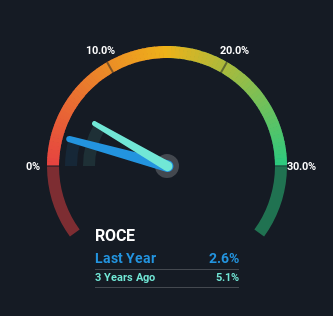Jiangsu Yawei Machine Tool (SZSE:002559) Could Be Struggling To Allocate Capital

What financial metrics can indicate to us that a company is maturing or even in decline? More often than not, we'll see a declining return on capital employed (ROCE) and a declining amount of capital employed. This combination can tell you that not only is the company investing less, it's earning less on what it does invest. On that note, looking into Jiangsu Yawei Machine Tool (SZSE:002559), we weren't too upbeat about how things were going.
Return On Capital Employed (ROCE): What Is It?
For those that aren't sure what ROCE is, it measures the amount of pre-tax profits a company can generate from the capital employed in its business. Analysts use this formula to calculate it for Jiangsu Yawei Machine Tool:
Return on Capital Employed = Earnings Before Interest and Tax (EBIT) ÷ (Total Assets - Current Liabilities)
0.026 = CN¥53m ÷ (CN¥4.5b - CN¥2.4b) (Based on the trailing twelve months to September 2023).
Therefore, Jiangsu Yawei Machine Tool has an ROCE of 2.6%. In absolute terms, that's a low return and it also under-performs the Machinery industry average of 6.0%.
View our latest analysis for Jiangsu Yawei Machine Tool

Above you can see how the current ROCE for Jiangsu Yawei Machine Tool compares to its prior returns on capital, but there's only so much you can tell from the past. If you'd like to see what analysts are forecasting going forward, you should check out our free analyst report for Jiangsu Yawei Machine Tool .
So How Is Jiangsu Yawei Machine Tool's ROCE Trending?
We are a bit worried about the trend of returns on capital at Jiangsu Yawei Machine Tool. About five years ago, returns on capital were 9.1%, however they're now substantially lower than that as we saw above. On top of that, it's worth noting that the amount of capital employed within the business has remained relatively steady. This combination can be indicative of a mature business that still has areas to deploy capital, but the returns received aren't as high due potentially to new competition or smaller margins. So because these trends aren't typically conducive to creating a multi-bagger, we wouldn't hold our breath on Jiangsu Yawei Machine Tool becoming one if things continue as they have.
While on the subject, we noticed that the ratio of current liabilities to total assets has risen to 54%, which has impacted the ROCE. If current liabilities hadn't increased as much as they did, the ROCE could actually be even lower. What this means is that in reality, a rather large portion of the business is being funded by the likes of the company's suppliers or short-term creditors, which can bring some risks of its own.
The Bottom Line On Jiangsu Yawei Machine Tool's ROCE
All in all, the lower returns from the same amount of capital employed aren't exactly signs of a compounding machine. Since the stock has skyrocketed 109% over the last five years, it looks like investors have high expectations of the stock. Regardless, we don't feel too comfortable with the fundamentals so we'd be steering clear of this stock for now.
If you want to know some of the risks facing Jiangsu Yawei Machine Tool we've found 5 warning signs (1 shouldn't be ignored!) that you should be aware of before investing here.
While Jiangsu Yawei Machine Tool may not currently earn the highest returns, we've compiled a list of companies that currently earn more than 25% return on equity. Check out this free list here.
New: Manage All Your Stock Portfolios in One Place
We've created the ultimate portfolio companion for stock investors, and it's free.
• Connect an unlimited number of Portfolios and see your total in one currency
• Be alerted to new Warning Signs or Risks via email or mobile
• Track the Fair Value of your stocks
Have feedback on this article? Concerned about the content? Get in touch with us directly. Alternatively, email editorial-team (at) simplywallst.com.
This article by Simply Wall St is general in nature. We provide commentary based on historical data and analyst forecasts only using an unbiased methodology and our articles are not intended to be financial advice. It does not constitute a recommendation to buy or sell any stock, and does not take account of your objectives, or your financial situation. We aim to bring you long-term focused analysis driven by fundamental data. Note that our analysis may not factor in the latest price-sensitive company announcements or qualitative material. Simply Wall St has no position in any stocks mentioned.
About SZSE:002559
Jiangsu Yawei Machine Tool
Manufactures and sells metal forming machine tools and laser processing equipment in China and internationally.
Adequate balance sheet with acceptable track record.


